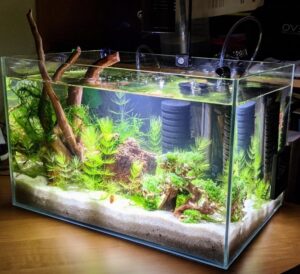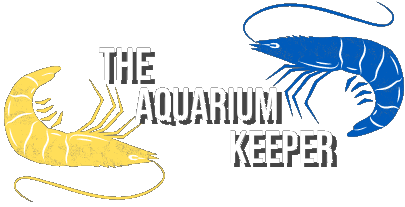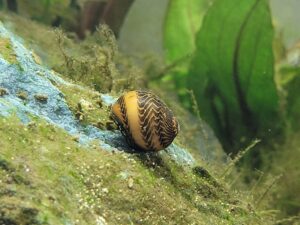
Pea Puffer: Adorable Little Hunter, Everything You Need To Know

Writer at The Aquarium Keeper
Pea puffer (Carinotetraodon travancoricus) is the smallest pufferfish in the world, that originates from India. Don’t let the adorable looks fool you – these little guys are excellent hunters and can be dangerous to other smaller fish.
This care guide will answer all the basic questions that come to mind when researching pea puffers: food, tank size, compatibility, breeding, and more. Continue reading to expand your knowledge!
What Do Pea Puffers Eat?
Dwarf pufferfish are carnivores, that thrive on frozen and live food. Pea puffers really love to hunt and eat live snails, so if you have a snail infestation in one of your aquariums, don’t be worried, because pea puffers will eat snails without a second thought.
This type of puffer also enjoys frozen bloodworms and brine shrimp, so be sure to have a variety of food for these little hunters. Every fish needs a lot of different nutrients to live a good life, and a lot of the time those nutrients can’t be given by feeding the fish only one type of food.
Can I Keep a Pea Puffer In a 5 Gallon Tank?
Unlike other pufferfish, pea puffers can be kept in smaller aquariums than usual. Although they look small and cute, pea puffers are very territorial fish, that require at least 5 gallons. It is recommended to keep only 1 pea puffer in a 5-gallon tank. If you are looking for a bigger pea puffer group, be sure to provide enough space to avoid possible fighting between fish.
10 gallons is ideal for only 3 pea puffers, and 20 gallons is good for a group of 6. Before you buy these adorable pufferfish, be sure to have a ratio of 1:2 when it comes to males and females. Like almost all aquatic creatures, males tend to fight more and be territorial, so be sure not to get too many males, otherwise rehoming some of them might be the best option to avoid aggression.
You might also like to read: 5 Gallon vs 10 Gallon Fish Tank: Comparison Guide
How Do I Sex Pea Puffers?
Males look slightly different than females, although the differences may only start showing when pufferfish pass the juvenile stage and become mature. If you end up with more males than females, relocation of some males is highly suggested, since males are very territorial and the weakest ones can live an unhappy life in those circumstances.
Male Dwarf Pufferfish Appearance
The first difference between males and females is aggression. Males are more territorial and aggressive than females. Also, just as a lot of fish in the aquarium hobby, males tend to be more colorful than females, they also have leaner bodies, while females are more rounded and have random spottings on the body.

Males also have a black stripe that goes through the center of their belly and sometimes wrinkles that form around their eyes, which females do not have. It is way easier to identify males because they have a couple of distinct features, while females tend to be slightly bigger, less colorful, and brighter pufferfish counterparts.
Female Dwarf Pufferfish Appearance
Females are less territorial and have rounded bellies, compared to male pea puffers. They also have dark spots all around their body, although it is important to know, that the pattern is different with every fish.

Females do not have a dark stripe on their bellies and wrinkles around their eyes, compared to their male counterparts. Since they are less territorial, female pufferfish spend way much more time searching for food and interacting with the environment.
What Do Pea Puffers Need In Their Aquarium?
First of all, pea puffers are purely freshwater fish and like water that is around 7 – 7.6 pH. As we mentioned before, dwarf pufferfish originate from Indian rivers and lakes, which means they enjoy lots of plants in their aquarium. If you are planning on keeping dwarf pufferfish, be sure to create a heavily planted aquarium for them. Pea puffers are tropical fish that thrive best in the 74 – 82°F temperature range, so if you live in a colder part of the world, be sure to get a heater. If your room temperature is similar to the required temperature, the heater is not needed.
You must have a good working filter if you are planning to keep pea puffers. These aquatic creatures produce waste, a filter will just make things better for your fish, just be sure that the filter flow is not too strong. Remember to provide a lot of hiding spots, where the line of sight can be broken, because males might fight over territory and in a strongly planted tank, they will see each other less. Having a lot of plants can reduce fighting and improve fish life overall.
You might also like to read: 10 Common Reasons Why Your Aquarium Plants Are Dying
Can I Keep Pea Puffers With Other Fish?
We highly suggest, that dwarf pufferfish should be kept in a tank, that is solely designed for them only. Pea puffers are territorial little creatures, who won’t hesitate to fin nip other fish, due to their behavior, pea puffers should be kept alone.
If you have a larger aquarium, that has a lot of plants and hiding spaces, you could try to keep similar size fish, that are faster than pea puffers, although we do not recommend it. Possible tank mates for pea puffers could be:
- Neon tetras
- Ember tetras
- Kuhli loaches
- Ghost shrimp
- Otocinclus
There is a possibility, that your pea puffer would still be aggressive towards other tank mates. Every pea puffer is different, so if something works for one fishkeeper, that does not mean it will work for you.
How To Breed Pea Puffers?
Pea puffers breed relatively easily if they live in an environment that replicates their natural surroundings. First of all, there has to be the right ratio of dwarf pufferfish, preferably 1:2 when it comes to males and females. It is also important to know, that dwarf pufferfish only breed when mature age is reached (usually 7 months).
First of all, pea puffers have to be fed good, protein-rich food, that can assure all the nutrients that the fish need. When pea puffers are ready to breed, males tend to become even more aggressive and territorial, whereas females spend more time around plants, looking for the best place to lay their eggs. Females only lay a handful of eggs at the same time, so carrying pea puffer babies will not be a hard task.
Adult dwarf pufferfish does not harm their offspring, so you do not need to separate them at any point. Fry infusoria is the best food for dwarf pufferfish babies, you can feed them brine shrimp when they become bigger.
Reasons Why You Should Get a Pea Puffer
Pea puffers are very interactive and fun to watch, although not the easiest fish to keep, so measure your experience before deciding if you want these cute little hunters. If you are still on the fence and have not yet decided, here are a few reasons why you should get a pea puffer.
Pea Puffers Are Very Smart
Dwarf pufferfish like to interact with their surroundings. Pea puffers can move their eyes, just like betta fish, so you can tell when these cute hunters are curious. With enough time, pea puffers can be trained to follow you from one aquarium side to the other, also they are smart enough to know when they are going to be fed, which is fun to watch.
Pea Puffers Are Exciting Hunters
Watching dwarf pufferfish hunting snails is one of the most amazing things about this fish. Pea puffers stalk their prey from different angles, before sucking the snails from their shells. This kind of hunting proves how smart these species are.
Writer's Thoughts And Personal Experience
Personally, I believe that pea puffers are one of the most interesting aquarium fish in the hobby. Dwarf pufferfish are very active, highly interactive creatures, that show their skills while hunting snails. Although it is not the easiest fish to take care of, I believe that every aquarist should create a pea puffer tank once in their lifetime.

Thank you for reading my blog post. This website was created with the sole intention of providing quality information regarding fishkeeping. I have been in the fishkeeping hobby for 8 years, and through many trials and errors as well as online research I gathered a lot of information, which I want to give back to the community.





